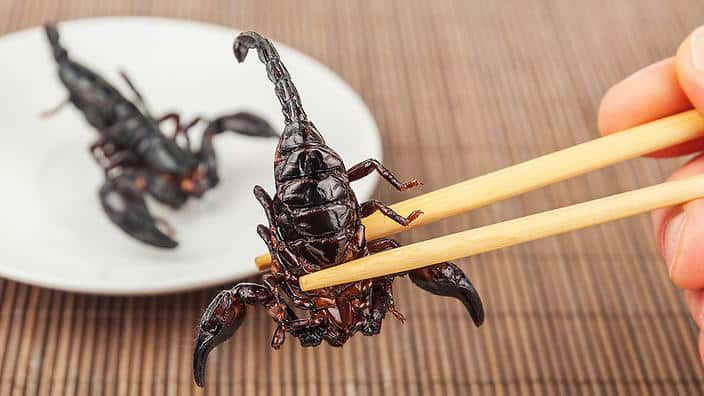
Imagine sitting down to dinner and being served a plate of snake, its venom potent enough to kill an elephant. It sounds like a nightmare, but across the globe, people routinely dine on some of the deadliest animals known to humankind. Despite the danger, these creatures are often considered prized delicacies, celebrated for their unique flavours, textures, or even supposed medicinal benefits.
From scorpion kebabs sizzling in Bangkok’s bustling street markets to elegant Tokyo restaurants serving potentially lethal pufferfish, the culinary world of deadly animals exists at the thrilling intersection of daring and gastronomy.
Here are ten deadly animals that brave souls across the world not only dare to eat, but actively seek out as delicacies worth risking their lives for.
ALSO READ: 5 reasons people ruin healthy relationships — Even when they don’t mean to
Deadly Animals That People Eat As Delicacies
1. Fugu (Pufferfish) – Japan
Arguably the most infamous deadly delicacy, fugu is a Japanese preparation of the pufferfish, which contains tetrodotoxin – a neurotoxin 1,200 times more toxic than cyanide. The toxin is primarily found in the fish’s liver, ovaries, and skin.
Only chefs who undergo years of rigorous training and pass strict examinations are legally allowed to prepare fugu. The preparation process involves skillfully removing the toxic parts while preserving the edible flesh.
Despite the lethal risk, fugu remains a symbol of culinary mastery in Japan, and diners pay handsomely for the experience – some even relishing the slight tingling sensation the toxin leaves on the tongue.
ALSO READ: 10 Ghanaian foods that are good for your heart
2. King Cobra – Southeast Asia
In regions of Thailand, Vietnam, and southern China, king cobras are not only revered but consumed as food and traditional medicine. The world’s longest venomous snake is prepared in specialist restaurants, where its venom is carefully extracted.
The preparation can be theatrical – the snake may be killed in front of diners, with its blood mixed into rice wine, and its heart occasionally consumed while still beating. The meat, believed to increase virility and stamina, is then stir-fried, grilled, or added to soups. Although the venom is deadly when injected, it is generally considered harmless if swallowed and digested properly.
ALSO READ: Top 10 African countries with the most expensive groceries
3. Stonefish – Australia and Asia
The stonefish holds the title of the world’s most venomous fish. Its dorsal fin spines can inject venom that causes intense pain, shock, and even death. Despite this, its flesh is regarded as a delicacy in Japan, parts of Southeast Asia, and northern Australia.
Preparation requires extreme care, with chefs meticulously removing the venomous spines before cooking. Once prepared, the meat is white, flaky, and said to be delicious. However, the risk lies entirely in the preparation – one mistake could prove fatal.
4. Scorpions – China, Thailand, and Mexico
Scorpions are commonly consumed in various cultures, particularly in China, Thailand, and Mexico. In China, they are often deep-fried and served as snacks in night markets or used in traditional medicine. In Thailand, they are grilled on skewers and served alongside curries.
Cooking neutralises the venom, making them safe to eat. Once fried, scorpions are crunchy and nutty, and considered not just a novelty but a source of protein and medicinal value.
ALSO READ: Top 10 delicious Indian street foods you must try today
5. Sea Snakes – Southeast Asia and Pacific Islands
Though they are among the most venomous reptiles on the planet, sea snakes are consumed in countries such as the Philippines, Vietnam, and Indonesia. Their meat is typically boiled or grilled, and the venom, dangerous when injected, is rendered harmless by heat during cooking.
Fishermen in these regions have inherited centuries-old techniques for capturing and preparing these slippery creatures. Sea snake meat is said to have a flavour similar to eel and is often used in soups and broths.
ALSO READ: Top 7 African countries with the best food - See where Ghana ranks
6. Centipedes – China and Southeast Asia
Giant venomous centipedes, like the Chinese red-headed centipede, are eaten in parts of China and Southeast Asia. Used in traditional medicine, they are believed to help with inflammation and chronic pain.
To prepare them for consumption, the fangs are removed and the centipedes are roasted or deep-fried. Their meat is crunchy, often served on skewers or in medicinal soups. Despite their unsettling appearance, they’re enjoyed as street food by locals and curious tourists alike.
ALSO READ: 6 essentials every Ghanaian should pack for the upcoming rainy season
7. Jellyfish – East Asia
Not all jellyfish are deadly, but some varieties consumed in East Asia do possess stinging cells capable of causing mild to serious reactions. In countries like China, Japan, and Korea, jellyfish are eaten raw or lightly cooked in salads and soups.
The preparation process involves removing the stinging tentacles and curing the flesh in salt and alum, which gives the jellyfish its signature crunch. While bland in flavour, jellyfish are appreciated for their texture and low calorie content.
ALSO READ: Here are 6 practical ways to boost your attention span
8. Tarantulas – Cambodia
In Cambodia, particularly the town of Skuon, fried tarantulas are a popular snack. The Cambodian zebra tarantula, although venomous, becomes safe to eat once deep-fried.
Preparation involves removing urticating hairs and fangs, then frying the spider until crispy. Seasoned with garlic, salt, and sometimes sugar, the legs are crunchy, while the abdomen is soft and pasty. Locals claim they are both tasty and nutritious, and they’ve become a popular roadside delicacy.
ALSO READ: Breakfast in bed and 5 other romantic gestures that will make your girlfriend happy
9. Cone Snails – Pacific Islands
Cone snails are among the most venomous marine creatures. Their venom can paralyse or even kill a human, and the toxin delivery system remains active after death.

















Facebook
Twitter
Pinterest
Instagram
Google+
YouTube
LinkedIn
RSS